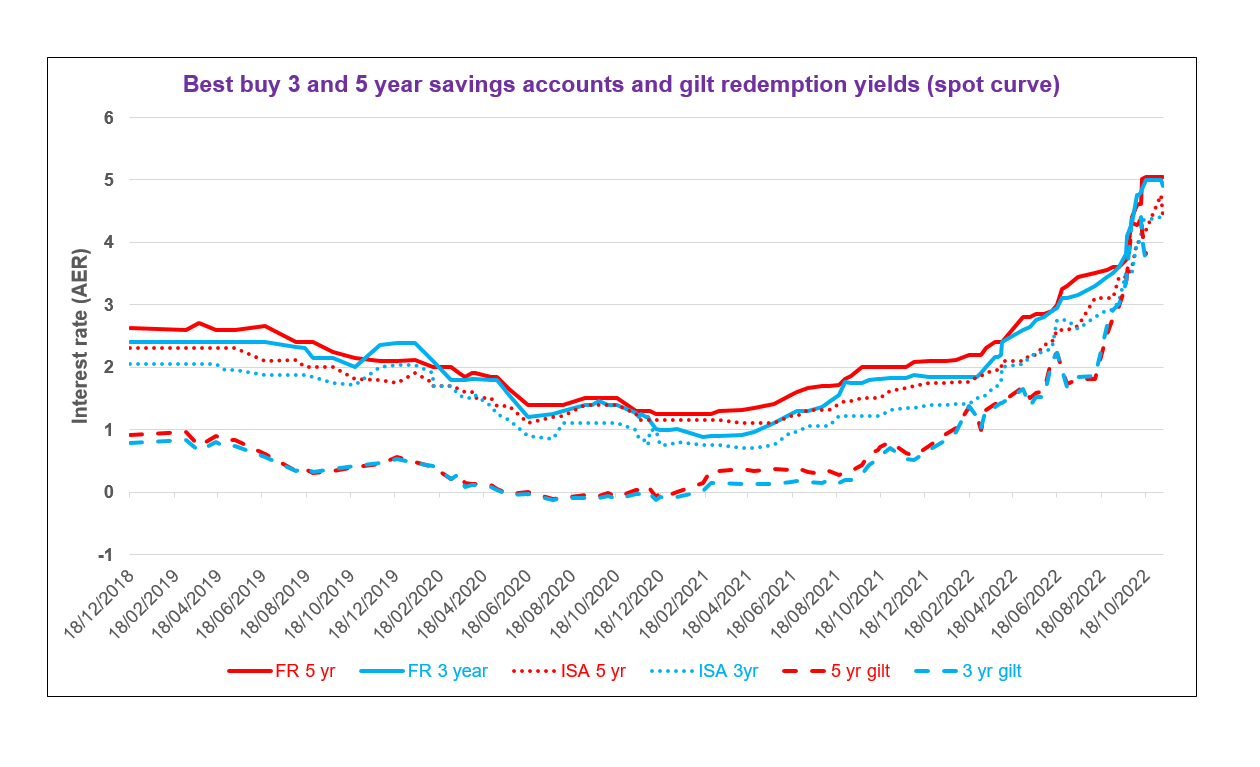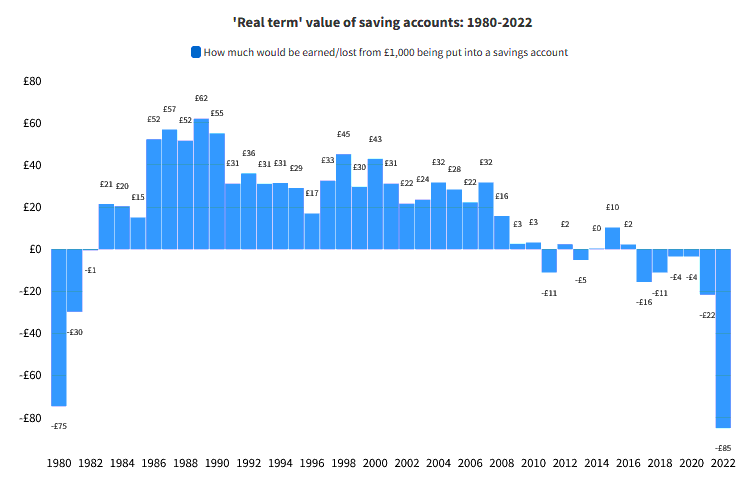We’d like to remind Forumites to please avoid political debate on the Forum.
This is to keep it a safe and useful space for MoneySaving discussions. Threads that are – or become – political in nature may be removed in line with the Forum’s rules. Thank you for your understanding.
The MSE Forum Team would like to wish you all a Merry Christmas. However, we know this time of year can be difficult for some. If you're struggling during the festive period, here's a list of organisations that might be able to help
📨 Have you signed up to the Forum's new Email Digest yet? Get a selection of trending threads sent straight to your inbox daily, weekly or monthly!
Has MSE helped you to save or reclaim money this year? Share your 2025 MoneySaving success stories!
Are savings rates on their way down?
Comments
-
Gilts are of course Tax free so you can't directly compare the Yields to maturity.SnowMan said:This was my earlier attempt to chart some of Ocelot's dataAdded in the 3 and 5 year gilt historical redemption yields from the (spot rates actually) also to see how the savings rates of 3 and 5 year fixed rates compared with gilt yields of the equivalent term at the same time points. It's why I prefer savings accounts to gilts generally in running alongside investments. 0
0 -
Bobajobbob said:
Gilts are of course Tax free so you can't directly compare the Yields to maturity.SnowMan said:This was my earlier attempt to chart some of Ocelot's dataAdded in the 3 and 5 year gilt historical redemption yields from the (spot rates actually) also to see how the savings rates of 3 and 5 year fixed rates compared with gilt yields of the equivalent term at the same time points. It's why I prefer savings accounts to gilts generally in running alongside investments. Fixed rate ISA savings accounts are tax free so you CAN directly compare AERs with gilt yields to maturity.Fixed rate non ISA savings interest where savings income falls within the personal savings allowance (£500 or £1,000) will also effectively be tax free.Fixed rate non ISA savings interest where savings income added to other income falls within the personal allowance will also effectively be tax free.Fixed rate non ISA savings interest where savings income falls within the £5,000 0% starting rate for savings (where non savings income is low enough for some or all of that band to apply) will effectively be tax free.So you can directly compare gilt yields to maturity either with AERs on fixed rate non ISA savings accounts or the AERs on fixed rate ISA savings accounts depending on circumstances.
Fixed rate ISA savings accounts are tax free so you CAN directly compare AERs with gilt yields to maturity.Fixed rate non ISA savings interest where savings income falls within the personal savings allowance (£500 or £1,000) will also effectively be tax free.Fixed rate non ISA savings interest where savings income added to other income falls within the personal allowance will also effectively be tax free.Fixed rate non ISA savings interest where savings income falls within the £5,000 0% starting rate for savings (where non savings income is low enough for some or all of that band to apply) will effectively be tax free.So you can directly compare gilt yields to maturity either with AERs on fixed rate non ISA savings accounts or the AERs on fixed rate ISA savings accounts depending on circumstances.
I came, I saw, I melted1 -
My BLME 90 day account has just increased the rate from 3.03% to 3.14% so they are still being competitive. I don’t think notice savings accounts with the main challenger banks have peaked. I’m thinking the middle of next year, maybe.0
-
First time buyer in the mid 90s, pretty much the direction of travel was to fix for up to 5 years or so if you could - Only towards the middle/end of my 25 year term did I stick with the variable rate.EssexHebridean said:Lovely as those savings rates are, the corresponding mortgage rates were rather more of an issue as I recall!
Also remember though that while mortgage rates were high, they were more affordable in relation to earnings
compared to current situation. In short, as long as you were in work, and avoided negative equity, it was a stretch at times
but it was usually doable.3 -
Interesting graphs, especially the correlation between 3/5 year rates, which seems to show how well banks can price their rates.
Lots of interesting, more generalised, graphs here too. https://www.finder.com/uk/inflation-vs-savings
Including this depressing one showing just 3 years in the last 10 gave savers even the smallest real return.
Not sure if the very useful site www.swallowpark.co.uk is around now. 8
8 -
Patr100 said:
First time buyer in the mid 90s, pretty much the direction of travel was to fix for up to 5 years or so if you could - Only towards the middle/end of my 25 year term did I stick with the variable rate.EssexHebridean said:Lovely as those savings rates are, the corresponding mortgage rates were rather more of an issue as I recall!
Also remember though that while mortgage rates were high, they were more affordable in relation to earnings
compared to current situation. In short, as long as you were in work, and avoided negative equity, it was a stretch at times
but it was usually doable.
I was a FTB in 1997 and I believe my mortgage rate was around 9%, but the remnants of MIRAS still existed then. Also, average semi-detached houses in Surrey were 60-90k then, now 450-900k.0 -
Fair points. When considering Gilts I tend to think in big minimum investment numbers as they are generally not retail products or easily accessible to retail and thus beyond the thresholds above.SnowMan said:Bobajobbob said:
Gilts are of course Tax free so you can't directly compare the Yields to maturity.SnowMan said:This was my earlier attempt to chart some of Ocelot's dataAdded in the 3 and 5 year gilt historical redemption yields from the (spot rates actually) also to see how the savings rates of 3 and 5 year fixed rates compared with gilt yields of the equivalent term at the same time points. It's why I prefer savings accounts to gilts generally in running alongside investments. Fixed rate ISA savings accounts are tax free so you CAN directly compare AERs with gilt yields to maturity.Fixed rate non ISA savings interest where savings income falls within the personal savings allowance (£500 or £1,000) will also effectively be tax free.Fixed rate non ISA savings interest where savings income added to other income falls within the personal allowance will also effectively be tax free.Fixed rate non ISA savings interest where savings income falls within the £5,000 0% starting rate for savings (where non savings income is low enough for some or all of that band to apply) will effectively be tax free.So you can directly compare gilt yields to maturity either with AERs on fixed rate non ISA savings accounts or the AERs on fixed rate ISA savings accounts depending on circumstances.1
Fixed rate ISA savings accounts are tax free so you CAN directly compare AERs with gilt yields to maturity.Fixed rate non ISA savings interest where savings income falls within the personal savings allowance (£500 or £1,000) will also effectively be tax free.Fixed rate non ISA savings interest where savings income added to other income falls within the personal allowance will also effectively be tax free.Fixed rate non ISA savings interest where savings income falls within the £5,000 0% starting rate for savings (where non savings income is low enough for some or all of that band to apply) will effectively be tax free.So you can directly compare gilt yields to maturity either with AERs on fixed rate non ISA savings accounts or the AERs on fixed rate ISA savings accounts depending on circumstances.1 -
Whilst capital gains are cgt-free the interest earned on gilts (small 'g') isn't. They are listed on the LSE's ORB so they're not hard to trade via a stockbroker that deals in them in small clips. Someone will be along to say the bid/offer spreads on small clips are wide but this hasn't been my experience.Bobajobbob said:
Fair points. When considering Gilts I tend to think in big minimum investment numbers as they are generally not retail products or easily accessible to retail and thus beyond the thresholds above.SnowMan said:Bobajobbob said:
Gilts are of course Tax free so you can't directly compare the Yields to maturity.SnowMan said:This was my earlier attempt to chart some of Ocelot's dataAdded in the 3 and 5 year gilt historical redemption yields from the (spot rates actually) also to see how the savings rates of 3 and 5 year fixed rates compared with gilt yields of the equivalent term at the same time points. It's why I prefer savings accounts to gilts generally in running alongside investments. Fixed rate ISA savings accounts are tax free so you CAN directly compare AERs with gilt yields to maturity.Fixed rate non ISA savings interest where savings income falls within the personal savings allowance (£500 or £1,000) will also effectively be tax free.Fixed rate non ISA savings interest where savings income added to other income falls within the personal allowance will also effectively be tax free.Fixed rate non ISA savings interest where savings income falls within the £5,000 0% starting rate for savings (where non savings income is low enough for some or all of that band to apply) will effectively be tax free.So you can directly compare gilt yields to maturity either with AERs on fixed rate non ISA savings accounts or the AERs on fixed rate ISA savings accounts depending on circumstances.1
Fixed rate ISA savings accounts are tax free so you CAN directly compare AERs with gilt yields to maturity.Fixed rate non ISA savings interest where savings income falls within the personal savings allowance (£500 or £1,000) will also effectively be tax free.Fixed rate non ISA savings interest where savings income added to other income falls within the personal allowance will also effectively be tax free.Fixed rate non ISA savings interest where savings income falls within the £5,000 0% starting rate for savings (where non savings income is low enough for some or all of that band to apply) will effectively be tax free.So you can directly compare gilt yields to maturity either with AERs on fixed rate non ISA savings accounts or the AERs on fixed rate ISA savings accounts depending on circumstances.1
Confirm your email address to Create Threads and Reply

Categories
- All Categories
- 352.9K Banking & Borrowing
- 253.9K Reduce Debt & Boost Income
- 454.7K Spending & Discounts
- 246K Work, Benefits & Business
- 602.1K Mortgages, Homes & Bills
- 177.8K Life & Family
- 259.9K Travel & Transport
- 1.5M Hobbies & Leisure
- 16K Discuss & Feedback
- 37.7K Read-Only Boards








